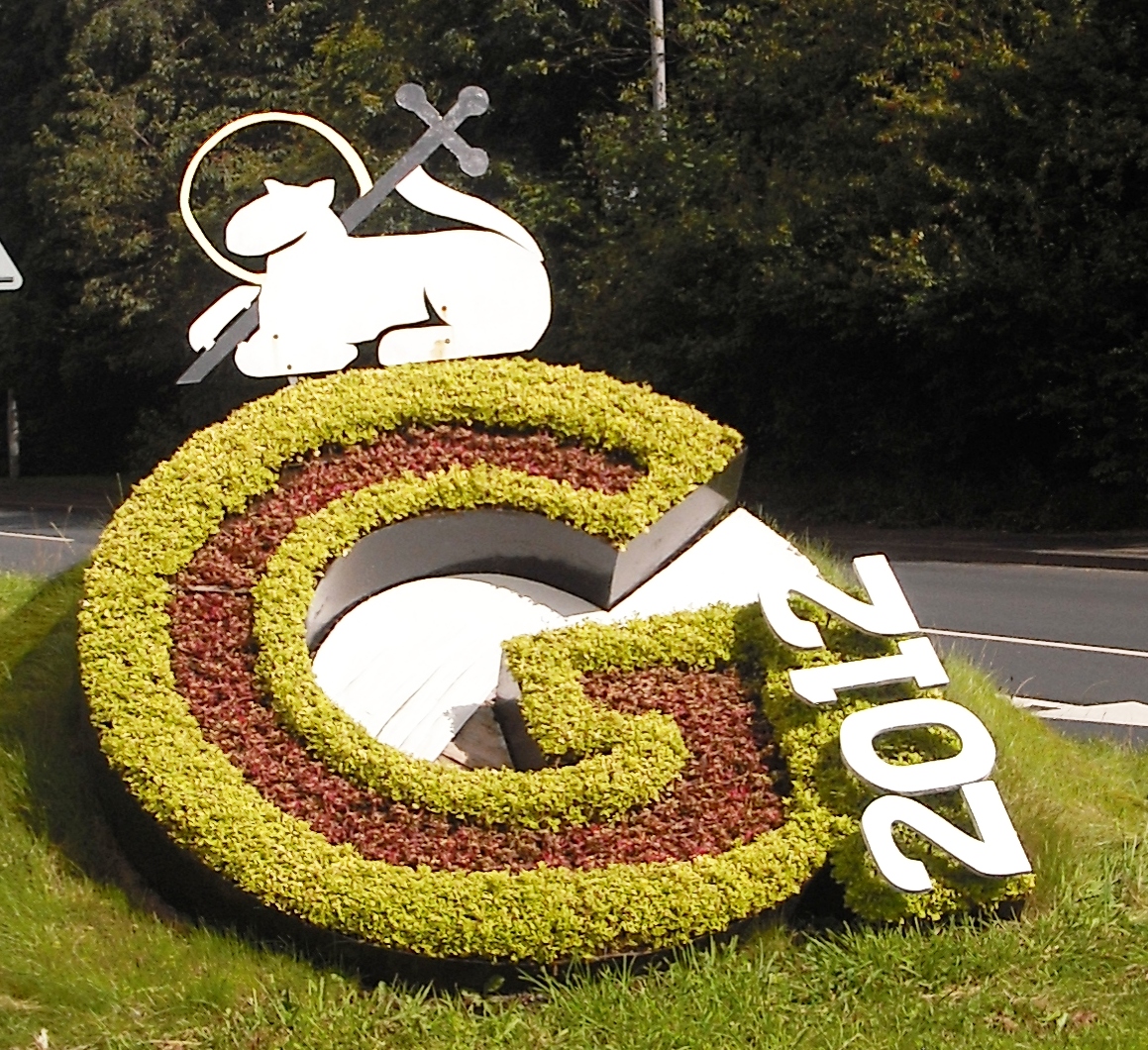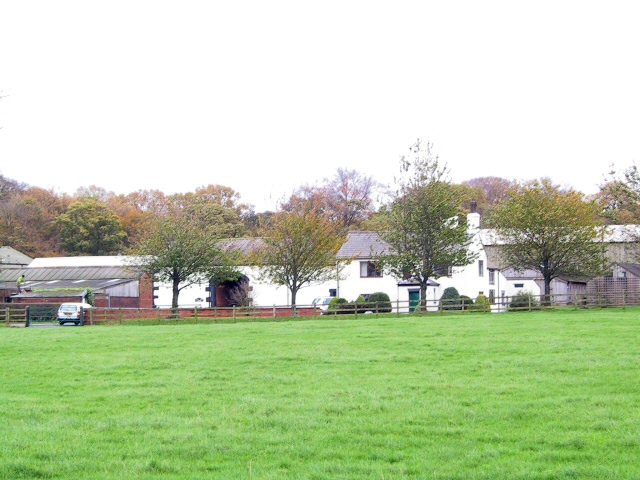|
Cuerden Hall
Cuerden Hall is a country mansion in the village of Cuerden near Preston, Lancashire, England. It is a Grade II* listed building. The Hall was formerly a family home between 1717 and 1906, and used by the Army until the 1960s. In 1985 it became a Sue Ryder neurological care centre. The Hall was sold to Manchester business man Colin Shenton in 2020 who is restoring it to its original purpose as a family home. The parkland and wider estate are known as Cuerden Valley Park. Cuerden Valley Park is now owned and managed by Cuerden Valley Park Trust which was a charity established in 1986, to ensure the longevity and management of the parkland itself. The Trust is made up for 650 acres of land; 1 reservoir, 15 ponds, 3 reed beds; over 5km of the river Lostock and 5 nature reserves. History The original house on the site which dated from the 17th century no longer exists. The Charnock family of Charnock Richard owned the estates until 1521, when Richard Charnock of Cuerden and Leyland s ... [...More Info...] [...Related Items...] OR: [Wikipedia] [Google] [Baidu] |
Preston, Lancashire
Preston () is a city on the north bank of the River Ribble in Lancashire, England. The city is the administrative centre of the county of Lancashire and the wider City of Preston, Lancashire, City of Preston local government district. Preston and its surrounding district obtained City status in the United Kingdom, city status in 2002, becoming England's 50th city in the 50th year of Elizabeth II of the United Kingdom, Queen Elizabeth II's reign. Preston had a population of 147,800 at the 2021 census, the City of Preston district 156,411 in 2023 and the Preston Built-up Area 313,322. The Preston Travel To Work Area, in 2011, had a population of 420,661, compared with 354,000 in the previous census. The south bank of the Ribble is part of the Preston urban area, although it forms the South Ribble borough that is administratively separate. Preston and its surrounding area have provided evidence of ancient Roman Britain, Roman activity, largely in the form of a Roman road that led ... [...More Info...] [...Related Items...] OR: [Wikipedia] [Google] [Baidu] |
First World War
World War I or the First World War (28 July 1914 – 11 November 1918), also known as the Great War, was a World war, global conflict between two coalitions: the Allies of World War I, Allies (or Entente) and the Central Powers. Fighting took place mainly in European theatre of World War I, Europe and the Middle Eastern theatre of World War I, Middle East, as well as in parts of African theatre of World War I, Africa and the Asian and Pacific theatre of World War I, Asia-Pacific, and in Europe was characterised by trench warfare; the widespread use of Artillery of World War I, artillery, machine guns, and Chemical weapons in World War I, chemical weapons (gas); and the introductions of Tanks in World War I, tanks and Aviation in World War I, aircraft. World War I was one of the List of wars by death toll, deadliest conflicts in history, resulting in an estimated World War I casualties, 10 million military dead and more than 20 million wounded, plus some 10 million civilian de ... [...More Info...] [...Related Items...] OR: [Wikipedia] [Google] [Baidu] |
Buildings And Structures In The Borough Of Chorley
A building or edifice is an enclosed structure with a roof, walls and windows, usually standing permanently in one place, such as a house or factory. Buildings come in a variety of sizes, shapes, and functions, and have been adapted throughout history for numerous factors, from building materials available, to weather conditions, land prices, ground conditions, specific uses, prestige, and aesthetic reasons. To better understand the concept, see ''Nonbuilding structure'' for contrast. Buildings serve several societal needs – occupancy, primarily as shelter from weather, security, living space, privacy, to store belongings, and to comfortably live and work. A building as a shelter represents a physical separation of the human habitat (a place of comfort and safety) from the ''outside'' (a place that may be harsh and harmful at times). buildings have been objects or canvasses of much artistic expression. In recent years, interest in sustainable planning and building pract ... [...More Info...] [...Related Items...] OR: [Wikipedia] [Google] [Baidu] |
English Heritage
English Heritage (officially the English Heritage Trust) is a charity that manages over 400 historic monuments, buildings and places. These include prehistoric sites, a battlefield, medieval castles, Roman forts, historic industrial sites, Listed building, listed ruins, and architecturally notable English country houses. The charity states that it uses these properties to "bring the story of England to life for over 10 million people each year". Within its portfolio are Stonehenge, Dover Castle, Tintagel Castle, and the "best-preserved" parts of Hadrian's Wall. English Heritage also manages the London blue plaque scheme, which links influential historical figures to particular buildings. When originally formed in 1983, English Heritage was the operating name of an executive non-departmental public body of the Her Majesty's Government, British Government, officially titled the Historic Buildings and Monuments Commission for England, that ran the national system of heritage prot ... [...More Info...] [...Related Items...] OR: [Wikipedia] [Google] [Baidu] |
Listed Buildings In Cuerden
Cuerden is a Civil parishes in England, civil parish in the Chorley (borough), Borough of Chorley, Lancashire, England. The parish contains four buildings that are recorded in the National Heritage List for England as designated listed buildings. Of these, one is listed at Grade II*, the middle grade, and the others are at Grade II, the lowest grade. The major building in the parish is Cuerden Hall; this and two structures associated with it are listed. The other listed building is a farmhouse. Key Buildings References Citations Sources * * * * * * * {{DEFAULTSORT:Cuerden Lists of listed buildings in Lancashire Buildings and structures in the Borough of Chorley ... [...More Info...] [...Related Items...] OR: [Wikipedia] [Google] [Baidu] |
North West District (British Army)
North West District was a district command of the British Army from 1967 and 1991. History The district was formed from 42nd (East Lancashire) Infantry Division as part of the Territorial Army Volunteer Reserve in 1967. It had its headquarters at Cuerden Hall, and was placed under the command of HQ UK Land Forces in 1972. In 1991, the first of the minor districts to be amalgamated were North West District, the former West Midlands District (by then Western District) and Wales, to form a new Wales and Western District. Commanders General officers commanding included: *1967–1968 Major-General Bala Bredin *1968–1970 Major-General Charles Dunbar *1970–1972 Major-General James Wilson *1972–1974 Major-General Corran Purdon *1974–1977 Major-General Keith McQueen *1977–1980 Major-General Peter Sibbald *1980–1983 Major-General Michael Hicks *1983–1986 Major-General Philip Davies Sir Philip Andrew Davies (born 5 January 1972) is a British Conservative politic ... [...More Info...] [...Related Items...] OR: [Wikipedia] [Google] [Baidu] |
Anti-Aircraft Command
Anti-Aircraft Command (AA Command, or "Ack-Ack Command") was a British Army command of the Second World War that controlled the Territorial Army anti-aircraft artillery and searchlight formations and units defending the United Kingdom. Origin The formation of a Command-level body of anti-aircraft defences had been announced in 1938, but Anti-Aircraft Command was not formed until 1 April 1939 under General Sir Alan Brooke, who had been commander of Anti-Aircraft Corps. He then passed control to Sir Frederick Pile, who remained in command until the end of the war.Routledge, Chapter 26. AA Command was under the operational direction of RAF Fighter Command as part of Air Defence of Great Britain, and occupied a headquarters known as ''Glenthorn'' in the grounds of Bentley Priory, home of Fighter Command. The majority of AA Command's guns and searchlights were operated by Territorial Army units. Some Regular Army units joined after they returned from the Dunkirk evacuation. L ... [...More Info...] [...Related Items...] OR: [Wikipedia] [Google] [Baidu] |
British Army
The British Army is the principal Army, land warfare force of the United Kingdom. the British Army comprises 73,847 regular full-time personnel, 4,127 Brigade of Gurkhas, Gurkhas, 25,742 Army Reserve (United Kingdom), volunteer reserve personnel and 4,697 "other personnel", for a total of 108,413. The British Army traces back to 1707 and the Acts of Union 1707, formation of the united Kingdom of Great Britain which joined the Kingdoms of Kingdom of England, England and Kingdom of Scotland, Scotland into a Political union, single state and, with that, united the English Army and the Scots Army as the British Army. The Parliament of England, English Bill of Rights 1689 and Convention of the Estates, Scottish Claim of Right Act 1689 require parliamentary consent for the Crown to maintain a peacetime standing army. Members of the British Army swear allegiance to the Charles III, monarch as their commander-in-chief. The army is administered by the Ministry of Defence (United Kingd ... [...More Info...] [...Related Items...] OR: [Wikipedia] [Google] [Baidu] |
Ministry Of Defence (United Kingdom)
The Ministry of Defence (MOD or MoD) is a Departments of the Government of the United Kingdom, ministerial department of the Government of the United Kingdom. It is responsible for implementing the defence policy set by the government and serves as the headquarters of the British Armed Forces. The MOD states that its principal objectives are to defend the United Kingdom of Great Britain and Northern Ireland and its interests and to strengthen international peace and stability. The MOD also manages day-to-day running of the armed forces, contingency planning and defence procurement. The expenditure, administration and policy of the MOD are scrutinised by the Defence Select Committee, except for Defence Intelligence which instead falls under the Intelligence and Security Committee of Parliament. History During the 1920s and 1930s, British civil servants and politicians, looking back at the performance of the state during World War I, concluded that there was a need for greater ... [...More Info...] [...Related Items...] OR: [Wikipedia] [Google] [Baidu] |
Second World War
World War II or the Second World War (1 September 1939 – 2 September 1945) was a World war, global conflict between two coalitions: the Allies of World War II, Allies and the Axis powers. World War II by country, Nearly all of the world's countries participated, with many nations mobilising all resources in pursuit of total war. Tanks in World War II, Tanks and Air warfare of World War II, aircraft played major roles, enabling the strategic bombing of cities and delivery of the Atomic bombings of Hiroshima and Nagasaki, first and only nuclear weapons ever used in war. World War II is the List of wars by death toll, deadliest conflict in history, causing World War II casualties, the death of 70 to 85 million people, more than half of whom were civilians. Millions died in genocides, including the Holocaust, and by massacres, starvation, and disease. After the Allied victory, Allied-occupied Germany, Germany, Allied-occupied Austria, Austria, Occupation of Japan, Japan, a ... [...More Info...] [...Related Items...] OR: [Wikipedia] [Google] [Baidu] |
Astley Hall (Chorley)
Astley Hall is a country house in Chorley, Lancashire, England. The building is now owned by the town and is known as Astley Hall Museum and Art Gallery. The extensive landscaped grounds are now Chorley's Astley Park. History The site was acquired in the 15th century by the Charnock family from the Knights of St John of Jerusalem. The Charnocks built the original timber-framed house, around a small courtyard, about 1575–1600. In 1665, Margaret Charnock married Richard Brooke of Mere in Cheshire (son of Sir Peter Brooke), and they built the present grand but asymmetrical front range of brick with a pair of vast mullion-and- transomed bay windows. This front has a doorway with distinctly rustic Ionic columns, remarkable at such a late date. The interior is notable for the mid-17th century plasterwork in the ceilings of the Great Hall and drawing room, which have heavy wreaths and disporting cherubs. Not all the moulding is of stucco: there are elements of lead and leather ... [...More Info...] [...Related Items...] OR: [Wikipedia] [Google] [Baidu] |
Lewis Wyatt
{{UK-architect-stub ...
Lewis William Wyatt (1777–1853) was a British architect, a nephew of both Samuel and James Wyatt of the Wyatt family of architects, who articled with each of his uncles and began practice on his own about 1805. Lewis Wyatt is known primarily for the English country houses he designed, which include Grade II* Cuerden Hall near Preston in 1816–1819, and for restoring and altering Lyme Park and Heaton Park. Between 1795 and 1800 he partially rebuilt Wythenshawe Hall. References 19th-century English architects 1777 births 1853 deaths Lewis Lewis may refer to: Names * Lewis (given name), including a list of people with the given name * Lewis (surname), including a list of people with the surname Music * Lewis (musician), Canadian singer * " Lewis (Mistreated)", a song by Radiohe ... [...More Info...] [...Related Items...] OR: [Wikipedia] [Google] [Baidu] |





